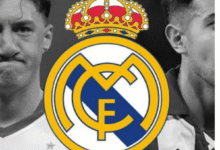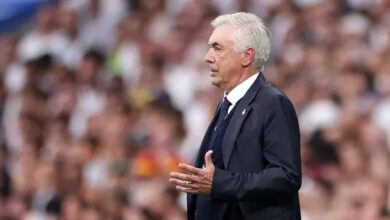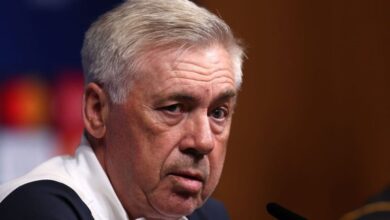Mbappé isperceived as having a bad integration with Real Madrid and is not acknowledged by his teammates.

Kylian Mbappé’s move to Real Madrid marks the fulfillment of a lifelong dream, a journey many young footballers can only fantasize about. For years, the Spanish giants have had their eyes on the prodigious talent, viewing him as the missing piece in their already star-studded lineup. The anticipation surrounding his arrival was palpable, with fans eagerly awaiting the moment when Mbappé would don the iconic white jersey. However, the initial excitement has been tempered by an unexpected sense of distance that seems to characterize his early days at the club.
Mbappé’s demeanor has sparked curiosity and concern among supporters, who have noticed a certain aloofness in his interactions on and off the field. This perceived detachment has left many puzzled, particularly given the magnitude of his transfer and the expectations that come with it. As one of the most coveted players in the world, his subdued presence is raising questions about his adaptation to life in Madrid.
The situation was further complicated by his surprising exclusion from Real Madrid’s squad on the day of his much-anticipated debut. When Mbappé finally took to the pitch, he was deployed in a central attacking role, flanked by Vinicius Jr. and Rodrygo, under Carlo Ancelotti’s tactical guidance. On paper, this seemed like a formidable trio, poised to wreak havoc on opposing defenses. Yet, as the match progressed, the initial buzz surrounding Mbappé’s positioning quickly gave way to a more critical analysis.Fans and pundits alike began to scrutinize his role, questioning whether placing him at the heart of the attack was the best use of his abilities. Traditionally, Mbappé has thrived on the wings, where his blistering pace and skillful dribbling allow him to exploit spaces and cut inside with lethal intent. This was a hallmark of his performances at PSG, where he consistently dazzled from the left flank, causing nightmares for defenders.
In contrast, a central role demands different attributes—holding up play, engaging in physical duels, and serving as a focal point for the team’s attacking movements. These responsibilities may not align perfectly with Mbappé’s natural tendencies, which lean more towards dynamic, wide play. The concern is that this new role could potentially stifle his creativity and limit his impact, making him appear less involved or even distant during the game.
Adding to this is the inevitable adjustment period that comes with transitioning to a new team, especially one as tactically sophisticated as Real Madrid. Every club has its unique system, and integrating into a new tactical framework often requires time and patience. Mbappé’s initial struggle to connect with his teammates and execute Ancelotti’s strategy might simply be a symptom of this transitional phase.
Despite the initial hiccups, there is no doubt that Mbappé possesses the talent and determination to succeed at Real Madrid. However, his debut has highlighted the need for a careful re-evaluation of his role within the team. By aligning his position with his strengths—perhaps by shifting him back to the wings—Real Madrid could unlock his full potential, ensuring that his dream move doesn’t turn into a period of unfulfilled promise. In the coming weeks, all eyes will be on how Ancelotti adjusts his tactics to maximize the impact of his new star, and how Mbappé responds to these challenges on the grand stage of the Santiago Bernabéu.
Kylian Mbappé’s highly anticipated move to Real Madrid was expected to be a seamless integration, fulfilling both his long-held dream and the club’s ambition to assemble an unstoppable team. However, the initial days of his tenure have not been without complications, sparking debate among fans and pundits about his fit within Carlo Ancelotti’s tactical setup.
Mbappé’s subdued demeanor since joining Real Madrid has raised eyebrows. Known for his confident and exuberant personality, his apparent detachment on and off the pitch has generated concern among supporters. This sense of aloofness is particularly striking given the monumental nature of his transfer, which many saw as the crowning moment of his career. The situation became more perplexing when he was unexpectedly left out of the squad on the day of his intended debut, fueling further speculation about his adaptation to the new environment.
When Mbappé did make his debut, Ancelotti positioned him centrally, with Vinicius Jr. and Rodrygo operating on the flanks. While this arrangement appeared formidable, doubts quickly arose regarding whether this role best utilized Mbappé’s skill set. Traditionally, he has excelled as a winger, where his explosive speed, dribbling, and ability to cut inside made him a nightmare for defenders. His new central role, however, demands different attributes—such as holding up play and engaging in physical duels—skills that are not typically associated with his natural game. As a result, his influence on the match seemed diminished, leading to questions about whether this position restricts his creativity and effectiveness.
These concerns are compounded by the inevitable adjustment period required when joining a new team, especially one as tactically intricate as Real Madrid. Each club’s system requires specific adaptations, and Mbappé’s initial struggles may be part of a broader learning curve. The challenge for Ancelotti will be to refine his tactics to better suit Mbappé’s strengths, possibly by shifting him back to his more familiar role on the wings.
Despite the initial challenges, Mbappé’s talent is unquestionable, and his success at Real Madrid is still within reach. However, the early signs suggest that careful consideration of his role is necessary to ensure that both the player and the club can fully capitalize on this landmark transfer. As the season progresses, the spotlight will remain on how Ancelotti adjusts his strategy and how Mbappé adapts to life in Madrid.








